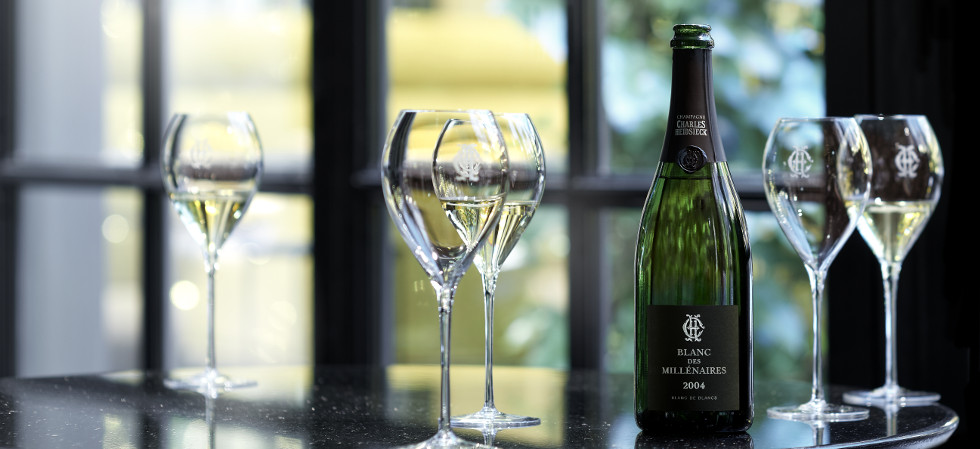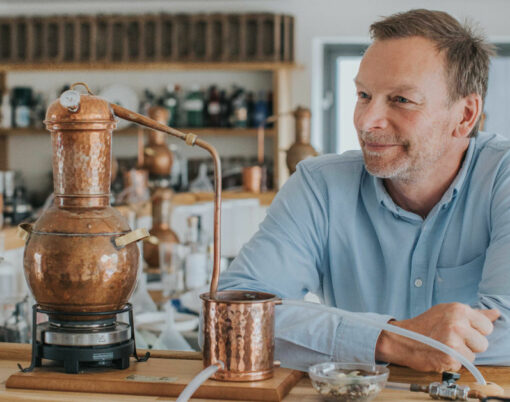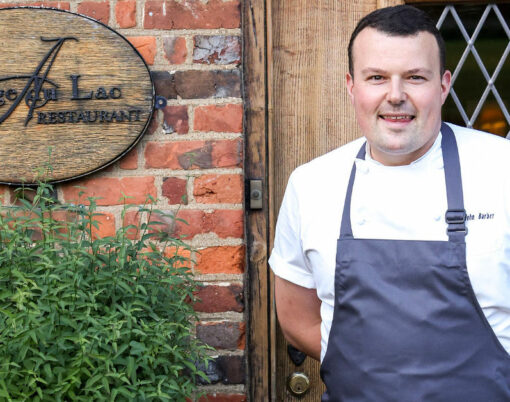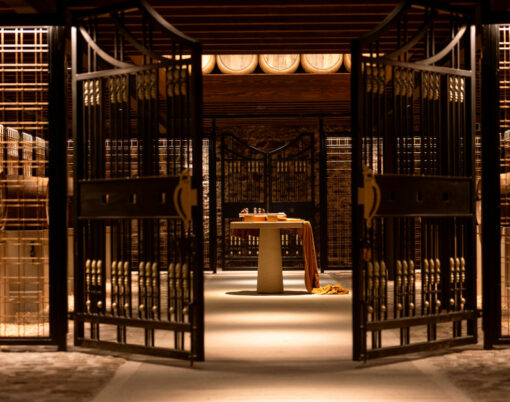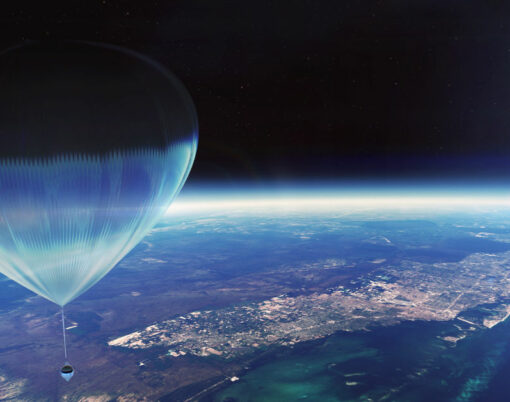I’m sat in a tranquil courtyard above Charles Heidsieck’s historic cellars in Reims, gazing at the idyllic gardens that cover the expansive grounds. Our host – international brand ambassador Sophie Kutten – pours three glasses of their flagship Brut Reserve. The colour is as golden as the hazy June sunshine, while the nose is multifaceted: buttered toast, dried fruits, pistachio and almonds all vie for attention. The palate is similarly evolved and complex, the finish long. And there’s also an added bonus: a bottle can be yours for less than £50. Compare that to say the Krug Grande Cuvee, which is exquisite but retails at around £140 a bottle. So it suddenly dawned on me. Charles Heidsieck Brut Reserve really is the best value Champagne around today.
Of course, the gorgeous setting did much to lubricate my mood, but it must be said that if first taste impressions really are everything, then Charles Heidsieck is a marketeers dream. The journey from Cardiff to Reims was similarly effortless – GWR, the firm that runs the South Wales to London franchise, has invested unprecedented amounts in a fleet of Hitachi high-speed trains. Enjoying the pampering comfort of the GWR 1st Class carriage, the journey was a delight, rather than an endurance. So too was the Eurostar effortless travel personified; enjoy the plush Business Premier lounge at London St Pancras International; depart on time; enjoy a pleasant meal, read for a bit and voila – Paris Gare du Nord. And then onwards to Reims.
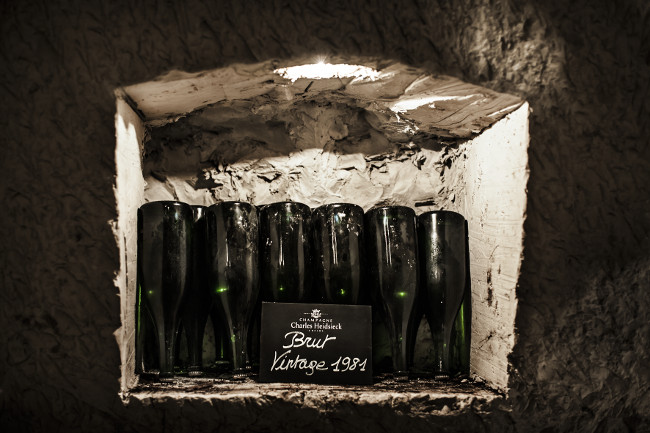
My two-day press trip encompassed the venerable houses of Charles and Piper Heidsieck – both brands are owned by parent company EPI. Piper-Heidsieck’s red label is familiar the world over thanks to its widespread retail distribution, while Charles Heidsieck has long been adored by critics and sommeliers. Both houses produce a range of Champagnes, from the entry level Brut NV (non-vintage) to a superlative prestige cuvee, and both houses are arguably underrated by the Champagne drinking public. Cristal and Ace of Spades may be the oligarch’s favourite, but Charles and Piper are every bit as worthy of lavish adulation as those better-known brands.
However, I’m must confess to an intractable bias – I’ve been a fan of these two houses for over a decade. Yet the trip was not simply a sycophant’s tour, rather it was an opportunity to further my knowledge of Charles and Piper’s history, and to get my teeth into their ‘soul.’ The first day saw Charles Heidsieck take centre stage – the portfolio tasting was one of the highlights of the trip. In addition to the always excellent Brut Reserve, the house makes a good rose and NV Blanc de Blancs, the latter being my favourite NV Champagne of the trip. The NV Rose, meanwhile, is composed of 36% Pinot Noir, 36% Chardonnay and 28% Pinot Meunier, and is widely considered one of Champagne’s best value roses.
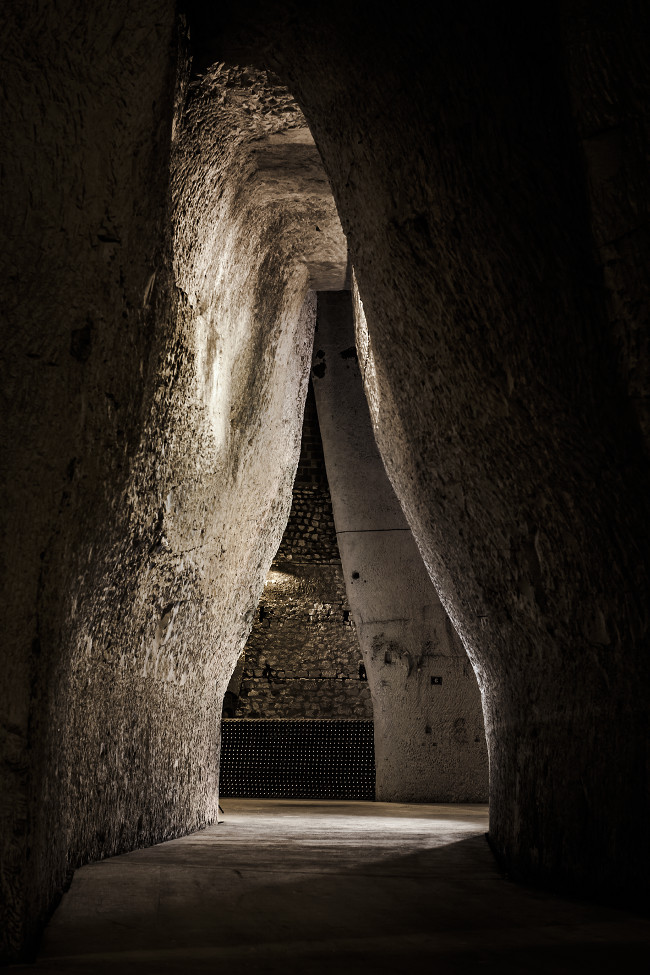
But it is the vintage releases and the prestige cuvee ‘Blanc de Millenaires’ that really elicit excitement in fizz aficionados. The 1995 vintage of this sensational Blanc de Blancs was described by Robert Parker’s Wine Advocate as: “An exquisite, perfumed, beautifully delineated Champagne, which retains plenty of freshness, verve and acidity.” During my trip, I tasted the 2006 vintage – the 2008 will be released in September 2019 – and the 2004 Blanc de Millenaires. There is actually little to chose between them – both exceptional Champagnes. The 2006 in particular was everything you’d expect from CH: intricate, rich and impeccably balanced Champagne. Green apple, lemon, plum, brioche and toast jumped out of the glass, while the palate boasted exceptional length and complexity. The temptation to linger on their terrace all afternoon was overwhelming, but our convivial host suggested that we tour the famous chalk cellars.
In those ancient, Roman-built white depths, I mused over the secret to Charles Heidsieck’s generous and toasty style. Current Chef de Cave (cellarmaster) Cyril Brun says that: “The winemaking philosophy today is based on two pillars: long maturation and significant amount of reserve wines. We age our NV wines from 6 to 7 years prior to releasing, in contrast the law stipulates a minimum period of 15 months.”
Nevertheless, Charles Heidsieck owes as much to its past as the present. The brand was founded by Charles Camille Heidsieck in 1851. He was the nephew of Florens-Louis Heidsieck – co-founder of what we today know as Piper Heidsieck. A natural showman, Charles wasted no time in bringing his product to the attention of connoisseurs in England and Belgium. Indeed, there was no limit to the man’s ambition. Travelling extensively across the US, Charles Heidsieck found an appreciative audience in Manhattan high society.
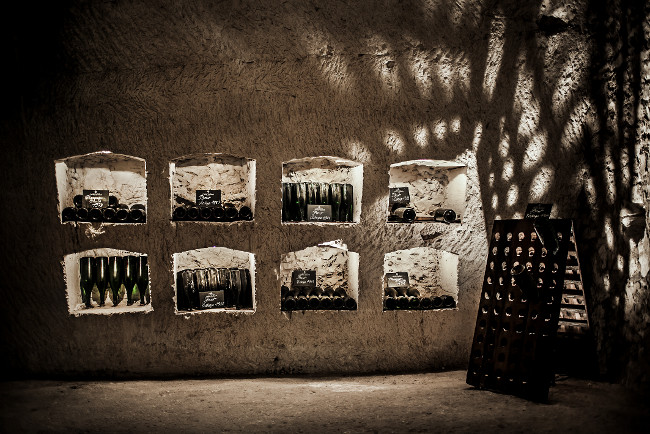
Yet it wasn’t all Champagne, chitter-chat and canapes. The outbreak of The American Civil War in 1861 caused Heidsieck more than a few headaches. Arriving in the US that year, Champagne Charlie found his agent unwilling to settle outstanding accounts, and seemingly no means of retrieving what he was owed. In desperation, he attempted to smuggle some cotton to Europe that was offered as payment from a merchant, but he was caught and imprisoned for spying in Fort Jackson, Louisiana.
After his death in 1893, CH went through a succession of different owners, until it was sold to French luxury goods group EPI, in 2011. It has remained in their capable hands ever since. Charles Camille Heidsieck, therefore, can be regarded as the brand’s godfather. The late cellarmaster Daniel Thibaut, however, was no less a vital part of the firm’s evolution and success.
One of his greatest innovations was introducing the Mis en Cave concept, whereby the label of the NV Brut Reserve displayed the year that the cuvée was put into the cellar for its second fermentation and ageing, as well as when it was disgorged. In addition, Thibaut was also responsible for defining the unusually complex and rich house style of the Charles Heidsieck Brut Reserve, by building up impressive stocks of reserve wines – wines kept back from previous vintages – at the expense of sales. Moreover, Thibaut insisted that 40% of reserve wines were to be used in each NV cuvee, a phenomenal amount of reserve wine even today, where most NV Champagnes perhaps use 10-12% on average. He also insisted on using reserves ranging across at least 7-8 vintages, whereas many houses just incorporate wines from the previous harvest or two. If Charles Camille is the godfather, Thibaut is the brand’s latter day saint.
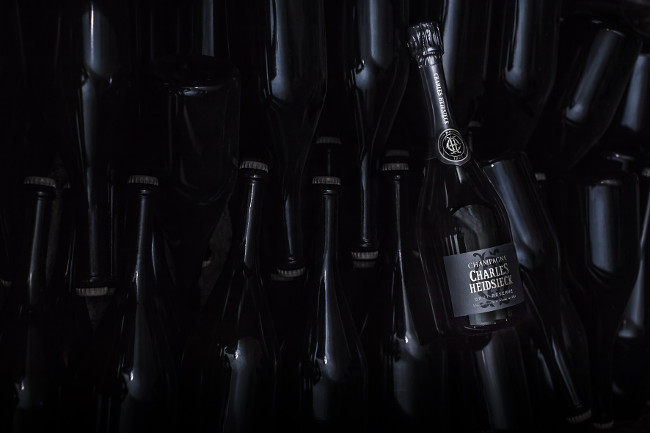
Dinner that evening was at Le Jardin, the more casual restaurant attached to luxury hotel Les Crayeres – a Champagne institution. The expansive summer terrace was full of tourists and locals, savouring the restaurant’s no-nonsense approach to local delicacies, and the magnificent surroundings. Warmly welcomed, we imbibed copious amounts of Brut Reserve and enjoyed a light supper before retreating to bed.
And so onwards to Piper-Heidsieck, EPI’s other venerable Champagne house. Piper has taken a very different trajectory to Charles – the marketing focused heavily on celebrity/film association in the 1990s, sold worldwide via the world’s supermarkets. The volumes produced are far in excess of Charles Heidsieck. And yet, and yet. There are treasures to be discovered, particularly in the vintage releases and their top-tier cuvee Rare, which is now marketed as a totally separate brand.
The tour started, understandably, with an ode to the brand’s history. The firms’ origins as a separate entity date back to 1834, when Christian Heidseick started his own company. After his death, Heidsieck’s widow married her brother-in-law, Henri-Guillaume Piper, and so H Piper & CO was born. Changing the branding from Heidsieck to Piper-Heidsieck in deference to their customers, Piper-Heidsieck enjoyed a succession of owners, until the brand was sold to Remy Cointreau in 1990. Maestro winemaker Regis Camus made Piper and Charles Heidsieck for many years, ensuring that the clear stylistic differences between the two brands were maintained. Both brands were purchased by EPI in 2011, although it is fair to say that Piper has changed the most since the sale.
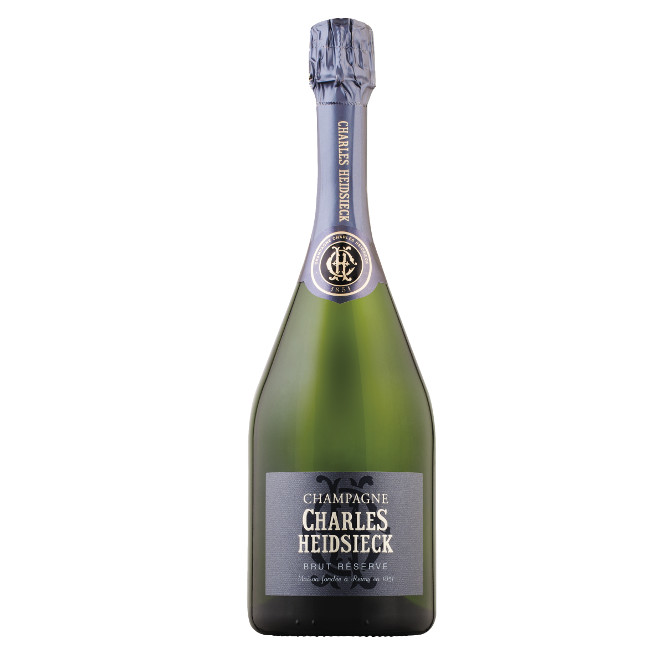
Indeed, the words ‘serious’ and ‘connoisseur’ were banded around a lot during our visit to the modern visitor centre – reserved for the wine trade and Piper aficionados rather than the public. The tasting included two relatively new additions to the Piper family: Essentiel Cuvee Reservee Extra Brut and Essentiel Blanc de Blancs Extra Brut. These are Champagnes designed to prove that Piper is not simply quaffable fodder. The wine trade have long known this fact, but Piper’s ubiquitous red label, a delicious and good value NV style, does arguably still ‘distract’ from the house’s key USP. Namely, producing high-quality Champagnes at the prestige level without the price tag.
The Essentiel Cuvee Reservee Extra Brut and Essentiel Blanc de Blancs Extra Brut are serious, gastronomic Champagnes that punch well above their weight and price points. The Blanc de Blancs Extra Brut in particular caught my eye. Or rather palate. The style is tight, structured and linear, with enough saline minerality to keep any fan of Albarino fan happy. The acidity streams across the palate, while the dosage levels – the sugar added before bottling – are a diet fanatics dream.
Nevertheless, my heart remains with the vintages. As is so often the case in Champagne, in all the excitement over the prestige labels, vintages are often unwisely overlooked. Both the 2008 and 2012 were singing – siren songs about depth, complexity and a force of flavour that beguiled our palates during lunch. They are simply lovely wines of inimitable style, with a focused intensity that makes them perfect for food. Moreover, unlike many top-end Champagnes, Pipers’ vintages can be enjoyed on release, or cellared if you’re so inclined.
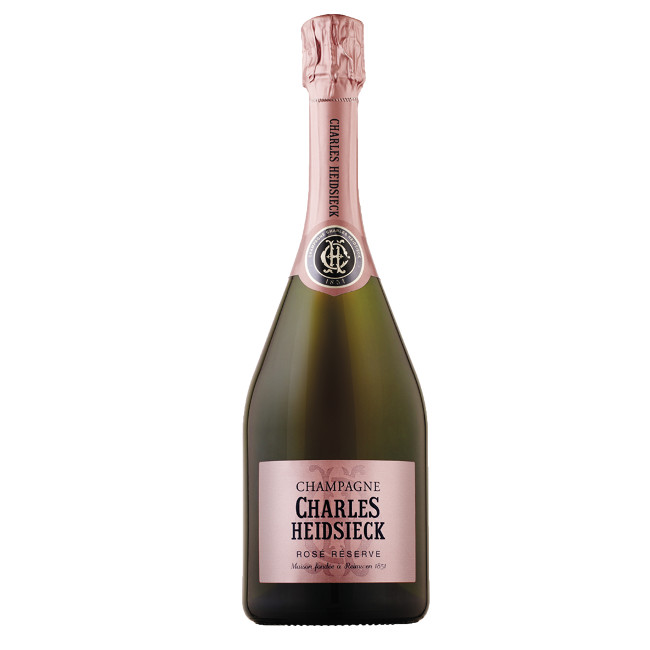
And then there’s Rare, the prestige cuvee that deserves to be as lauded as Dom Perignon and Krug. Prestige cuvees have traditionally been marketed as the top-tier Champagne of a house’s portfolio, however, Piper is leading the way in marketing their prestige cuvee as a totally separate entity, rather than as the top-tier offering.
According to Piper-Heidsieck’s CEO Damien Lafaurie, the decision to market Rare as a totally separate brand was taken three years ago.
“Rare has its own personality that deserves to be managed separately,” said Lafaurie. “It will definitely help Rare to build its own reputation; the target consumer for Rare is slightly different from the one targeted by Piper. The very selective places around the world where we want to offer Rare are also different from Piper. Rare will now get the full attention of our distributors in key markets,” he added.
The maison’s CEO also hinted that a new prestige label, marketed as part of the Piper range, would eventually be introduced to replace Rare. “We might introduce in the coming years a new “top” cuvée for Piper, which is fully consistent with the style of the Maison,” admitted Lafaurie.
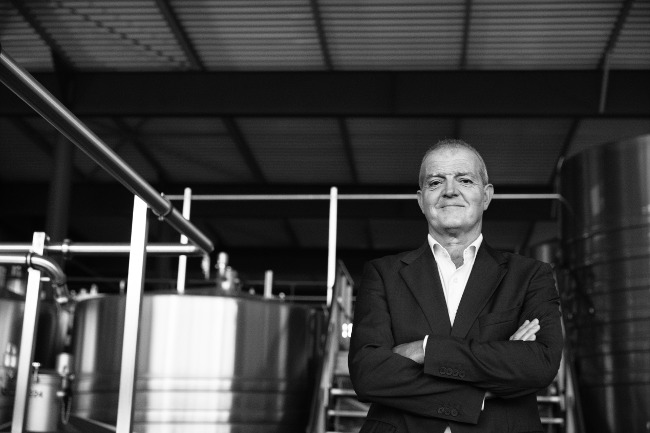
Yet Rare has a relatively short history. It was first introduced in 1976, and since then less than 8 vintages have been released. The 2002 is my favourite, an explosive Champagne that is bursting with force and finesse, honeysuckle, coffee cream and gallons of fruit. A hedonists dream.
Unfortunately, though, from a marketing point of view, Rare still carries less bragging rights than an old vintage of Krug. But in the end, it all revolves around what you want from your bottle of expensive fizz.
Need to make a statement? Simple, order a bottle of Dom Perignon or Ace of Spades in a trendy London nightspot, invite your friends, pop the cork, and create a scene. Job done. But, as you’re reading this article, let’s assume you are just as interested in the wine inside the bottle, as the label. If that’s the case then you will definitely want to check out these irresistible Champagnes below. As I said, these bottles come with less bragging rights than the superstar names, but then true wine lovers have never been interested in status symbols or the speculative power of wine. They buy for pleasure, not for profit, something that Charles and Piper-Heidsieck offer in generous abundance.
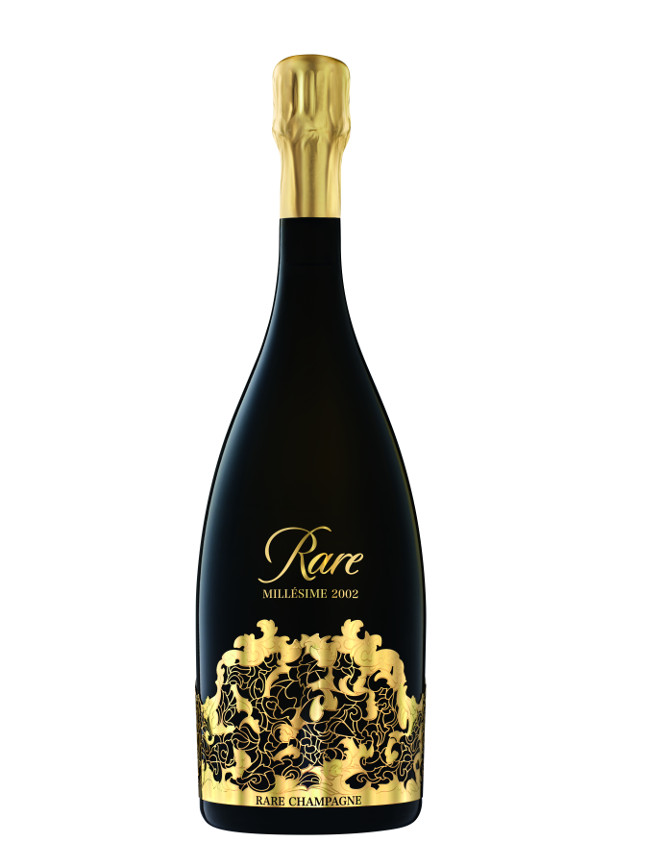
Where to buy the wines:
Charles Heidsieck Brut Reserve (£39.83) – masterofmalt.com
Charles Heidsieck 2006 (£84.95) – thewhiskyexchange.com
Charles Heidsieck Banc des Millenaires 1995 (£149) – thewhiskyexchange.com
Piper-Heidsieck Essentiel Blanc de Blancs (£46.50) – qwines.co.uk
Piper-Heidsieck 2012 vintage (£54.95) – thewhiskyexchange.com
Piper-Heidsieck Rare 2002 (£195) – selfridges.com
Fact box
Transfers to Paddington were supported by GWR – www.gwr.com. Singles from Cardiff to London Paddington are available from under £30 each way.
Eurostar has daily trains from London St Pancras International to Paris Gare du Nord – eurostar.com/uk-en.












